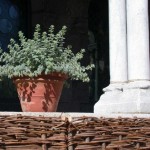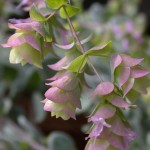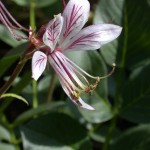 |
 |
 |
Above: The left and center image show the true or “right dittany” of Crete (Origanum dictamnus), a tender Mediterranean species grown in pots in Bonnefont garden. This pretty relative of the culinary oreganos is endemic to the island, and is found growing wild only in the mountains there. The small, purplish-pink flowers are borne on long-lasting bracts in late summer and fall. The image on the right shows Dictamnus albus, known as white dittany or fraxinella, which is a botanically unrelated species. Medieval herbalists seem to have transferred both the name and the??marvelous properties that the ancients ascribed to true dittany to this herb.
Origanum dictamnus, with its round, woolly gray leaves,??rosy??bracts and delicate purplish-pink flowers, is the prettiest of the tender medieval species grown in pots in Bonnefont garden, and the most difficult for us to grow. One of a number of species endemic to the mountains of Crete, the wild plant is only found growing in the crevices of limestone gorges and ravines (see image). Known as diktamnon in Greek, it is said to be named after Mount Dikti.
Accredited with many powers by ancient authorities, dittany of Crete was perhaps most famous as a wound herb and as an antidote to the venom of poisonous creatures. The Greek botanist Theophrastus, following his master Aristotle, maintained that the wild goats of Mount Ida, when stricken by the arrows of hunters, would seek out the herb and eat it. The arrows would drop from their bodies and the wounds would be cured. This story was repeated by Dioscorides (De materia medica, Book III.37),??who lists a number of alternative names for the herb he calls diktamnon, including artemidon, after the goddess Artemis, goddess of the hunt, who could both deliver wounds and heal them. Dioscorides maintains that the juice of the plant cures any injury caused by iron, whether dropped into the wound or taken as a drink.
Dittany’s reputation as a sovereign wound herb is maintained by the Roman poet Virgil in Book XII of the Aeneid, in which the goddess Venus herself brings a branch of the herb from Mount Ida to Italy to heal the wound dealt in battle to her son Aeneas.
Dioscorides also dilates on dittany’s reputed power against snakes and snakebite: the dried herb, rubbed between the hands into a meal and mixed with a little wine, could be spread on the body to repel serpents. Even the smell of dittany was said to drive away poisonous creatures, and the touch of it was enough to kill them.
In The Greek Plant World in Myth, Art and Literature, the author Hellmut Baumann avers that the dried form of this Cretan herb was widely exported as early as the fifth century B.C. and was used by Hippocrates in his medical school on the island of Cos. Twenty centuries after Hippocrates, William Turner, the father of English botany, records that this Cretan dictamnus, which he had never seen growing but had often seen dry, was available in Venice and Antwerp.
But is this Cretan dictamnus the dictamnus of the Middle Ages? In his fundamental work, Medieval Gardens, John Harvey discusses the uncertainties inherent in the identification of botanical species in the famed ninth-century edict Capitulare de villis, in which the emperor Charlemagne decreed which plants were to be grown on the imperial estates. Harvey cites “dictamnus” as an example; more than one plant was known by that name, and Origanum dictamnus would be an unlikely candidate for cultivation in northern Europe. In The Names of Herbes, published in 1548, Turner had already remarked on the misapplication of the name dictamnos, proper to Origanum dictamnus, which he terms “righte Dittany,” to fraxinella, which is Dictamnus albus, or to yet another herb he calls Lepidium. According to Harvey, the name “dittany” in medieval English sources is usually equated with dittander, or watercress (Lepidum latifolium). Harvey suggests yet another possible identification with Balotta pseudodictamnus (see image).
An image of “dictamo” from an Italian herbal ca. 1500 representing white dittany or fraxinella rather than dittany of Crete is available in The Index of Medieval Medical Images (see image).
Frank Anderson identifies the herb named in Chapter 50 in the fifteenth-century Herbarius Latinus as white dittany, Dictamnus albus; this plant shares the power to close up wounds and drive venomous animals from the house ascribed to the true or right dittany, Origanum dictamnus.
???Deirdre Larkin
Sources
Anderson, Frank J., ed. “Herbals through 1500,” The Illustrated Bartsch, Vol. 90. New York: Abaris, 1984.
Baumann, Hellmut. The Greek Plant World in Myth, Art, and Literature. Translated and augmented by William T. Stearn and Eldwyth Ruth Stearn. Portland, OR: Timber Press, 1993.
Britten, James, ed. The Names of Herbes by William Turner, 1548. London: Published for the English Dialect Society by N. Tr??bner & Company, 1881.
Grieve, Maude. A Modern Herbal. 1931. Reprint: New York: Dover Publications, 1971.
Griffiths, Mark. The New Royal Horticultural Society Index of Garden Plants. Portland, OR: Timber Press, 1992.
Gunther, Robert T., ed. The Greek Herbal of Dioscorides, translated by John Goodyer 1655. 1934. Reprint: New York: Hafner Publishing, 1968.
Harvey, John. Medieval Gardens. Beaverton, Oregon: Timber Press, 1981.
Tags: Aeneas, antidote, Aristotle, artemidon, Artemis, Bonnefont Garden, Cos, Crete, diktamnon, Dioscorides, Hellmut Baumann, Hippocrates, Mount Ida, Origanum dictamnus, snake, snakebite, Theophrastus, venom, Venus, Virgil, William Turner

February 22, 2011 at 11:36 am
Thanks Deirdre, this is one of the more comprehensive historical write-ups I’ve found regarding this plant online. Am planning to go to Crete to do some more direct research on the subject!